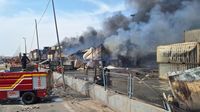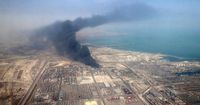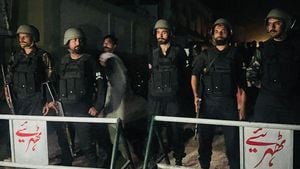In a tragic incident that has sent shockwaves across Iran, a massive explosion at the Shahid Rajaee port near Bandar Abbas has resulted in the deaths of at least 40 people and injuries to over 1,000 others. The explosion, which occurred on Saturday, April 26, 2025, has raised serious concerns about safety protocols at the country’s largest commercial port, which handles approximately 80% of Iran's imports.
Iran’s President Masoud Pezeshkian visited the site on Sunday to assess the situation and meet with survivors. He expressed gratitude to first responders and assured that the government would support the families of the victims. "We have come to see first-hand if there is anything or any issue that the government can follow up on," Pezeshkian stated, emphasizing the government's commitment to addressing the aftermath of the disaster.
The explosion reportedly stemmed from a fire that ignited at a hazardous materials storage depot within the port. Eyewitness accounts and video footage suggest that chemicals in shipping containers caught fire, leading to the catastrophic blast. According to the state-run Islamic Republic News Agency, the Customs Administration of Iran has attributed the explosion to a stockpile of hazardous goods stored in the port area.
Adding to the complexity of the situation, reports have emerged linking the explosion to sodium perchlorate, a chemical commonly used in missile propellant. A source connected to Iran’s Islamic Revolutionary Guard Corps revealed that the material was likely involved in the blast. This revelation has prompted scrutiny over the handling of such dangerous materials in a civilian port.
Security analysts from Ambrey Intelligence suggested that the explosion was a result of improper storage of the sodium perchlorate, which was shipped to Iran from China. The Financial Times reported that two shipments totaling over 1,000 tons of the chemical had arrived at the port in early 2025. This quantity is significant enough to potentially fuel hundreds of ballistic missiles, raising alarms about the implications of military-grade materials being present at a commercial facility.
In response to the incident, Iranian officials, including the Minister of Roads and Urban Development, Farzaneh Sadegh, stated that only one area of the port was affected, and operations in other zones were continuing as normal. However, the situation remains precarious, with emergency workers still battling fires that have engulfed parts of the port.
As the aftermath of the explosion unfolded, the Iranian health ministry issued warnings to residents in nearby towns to remain indoors and wear protective clothing due to the toxic smoke and chemicals released into the air. Schools and offices in Bandar Abbas were closed to facilitate emergency response efforts.
The Iranian government has declared a day of national mourning on Monday, April 28, 2025, with additional mourning days in Hormozgan province. Messages of solidarity have poured in from around the world, with countries like the United Arab Emirates, Saudi Arabia, and Russia expressing condolences.
In a bid to control the situation, Russian President Vladimir Putin has ordered multiple firefighting aircraft to assist Iranian authorities in extinguishing the flames. The Kremlin’s support underscores the international ramifications of the disaster, given the strategic importance of the Shahid Rajaee port in the Strait of Hormuz, a crucial shipping lane for global oil transport.
As investigations into the cause of the explosion continue, questions remain about the safety measures in place at the port and the potential for future incidents. The Iranian authorities have vowed to conduct a thorough investigation, with Supreme Leader Ayatollah Ali Khamenei emphasizing the need to uncover any negligence or intent behind the explosion.
The explosion comes at a time of heightened tensions in the region, coinciding with ongoing negotiations between Iranian and U.S. officials regarding Tehran’s nuclear program. The timing has led some to speculate about the implications of the blast on these sensitive talks.
While Iranian officials have denied that any military materials were stored at the port, the presence of sodium perchlorate has sparked a blame game among citizens and analysts alike. Many are questioning how such dangerous materials could be stored in a civilian area without proper oversight, leading to calls for accountability from the government.
As the nation grapples with the aftermath of this disaster, the focus will undoubtedly shift to the broader implications for Iran’s economy, particularly if the port remains temporarily closed. The Shahid Rajaee port is vital for the importation of goods, and any disruption could lead to shortages and economic strain.
The Iranian leadership faces a significant challenge in addressing public anger over perceived incompetence and ensuring that a tragedy of this magnitude does not occur again. With the nation in mourning, the call for answers and accountability grows louder.
As the situation develops, the world watches closely, with many hoping for a swift recovery for the victims and their families while also seeking clarity on the events that led to this tragic explosion.






